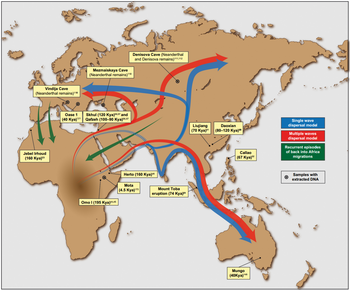Early human migrations
Early human migrations means the way archaic and modern humans moved out of Africa and across continents.
About two million years ago, Homo erectus groups moved out of Africa. This has been known for some time, because a few of their skulls have been found in Asia. One example was found in China before WWII, and lost during the fighting. Other examples have since been found in various parts of Asia.
The first migration was followed by other early human species including H. heidelbergensis. This lived about 500,000 years ago. It was the likely ancestor of Denisovans and Neanderthals, as well as modern humans. Early hominids probably "crossed land bridges that were eventually covered in water".[1] It is worth remembering that the Earth was generally much colder, with more ice bridges than the present world.

The migrating modern human populations are known to have interbred (mated) with earlier local populations. Therefore, modern human populations are descended in small part (below 10% contribution) from regional varieties of archaic humans.
Related pages
changeReferences
change- ↑ Delson, Eric 2019. An early dispersal of modern humans from Africa to Greece. Analysis of two fossils from a Greek cave has shed light on early hominins in Eurasia. One fossil is the earliest known specimen of Homo sapiens found outside Africa; the other is a Neanderthal who lived 40,000 years later. Nature 571 (7766): 487–488. [1]